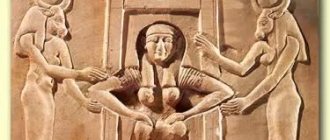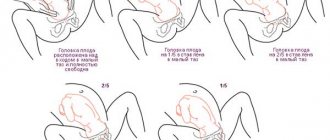If you believe the physiological point of view, then a healthy woman is quite capable of giving birth to a child without too much pain, deformation or rupture of the genital organs. In order for the body to fully prepare for the birth of a child, it has nine months, and this is not so little. This time is enough for the tissues of the birth canal to become softer, more elastic, and stretch easily so as not to injure the baby.
It is worth noting a rather interesting fact: not a single creature on the planet experiences terrible pain during childbirth, because this process is perceived as completely natural. At the same time, physiologists two centuries ago proved that pain during childbirth is caused either by the presence of pathologies, diseases, or by fear and severe stress. Accordingly, none of this should be present either during pregnancy or during childbirth.
If we talk about the reasons that can cause pain during the birth process, then they include:
- the woman’s age and health status;
- features of the anatomical structure of a woman’s body: the size of the pelvis, the state of the muscular, hormonal and other systems that play an important role during childbirth;
- if there were disruptions in the menstrual cycle before pregnancy, this may also affect childbirth;
- premature birth, when the body has not yet had time to fully prepare for this process;
- fetal size and position;
- the woman’s pain threshold level and her mental state.
A very important role during childbirth is played by the psychological state of the woman, as well as how much she can overcome her fear. There is no need to assume that too intense pain occurs because the cervix is preparing for the birth of a child.
Causes of pain before childbirth
The first common cause of pain before childbirth is false contractions. These contractions are training contractions; they literally tone the uterus for a minute and force it to contract. Such sensations occur after the 20th week of pregnancy and may cause slight discomfort, but not severe pain. Of course, every day these sensations may become more and more unpleasant, but the pain can only be felt in the lower abdomen. This is the main difference from real contractions, which will be regular, and the pain before childbirth will begin from the lower back. More severe pain may occur directly during contractions, when the uterus expels the fetus.
The most important cause of pain during childbirth remains the psycho-emotional state of a woman. Because of fear, a woman cannot completely relax, she begins to tighten her muscles, and this causes severe pain. The more a woman strains, the more she will interfere with the natural process and stretching of muscles and ligaments.
The causes of pain can be pathological diseases, a woman’s narrow birth canal, or a pelvis that is too narrow. In addition, the ability to relax has a very strong influence; try to learn how to do this during pregnancy and then childbirth with a minimum amount of pain is guaranteed.
What helps reduce the pain of contractions
Attitude is important
There is an opinion that pain during childbirth can be reduced to zero. I have not met women who did not experience pain at all, but everyone unanimously repeats in the reviews that rumors about the pain of contractions are exaggerated. And most importantly, after giving birth, a woman quickly forgets these experiences.
Therefore, let's agree that we will not be afraid and will have a positive : if you do not shrink in fear of what is coming, then nothing painful will happen.
Relax and have fun! You are about to meet your baby - think about it! And you will also get rid of that boring belly and become light and airy again!
Movement
Previously, women were prohibited from getting out of bed during labor. Poor things! After all, it is known that tension in any muscles is easier to overcome or relieve by moving .
You can and should walk ! In ancient times, women did not lie down at all during childbirth - children came out more easily under the influence of gravity, so they gave birth on their haunches or in special chairs. And recumbent childbirth was invented, they say, for one curious French king who wanted to see how it happens.
Today, doctors recommend walking, doing exercises, and even dancing while waiting for the uterus to open.
Ball
The fitball is great for helping with contractions. Only it should not be fully inflated so that the ball is soft. Then it is comfortable to sit on it, swing, spring, rotate the pelvis, roll, which relaxes the muscles and helps accelerate the dilation of the cervix.
Reviews of postpartum women about childbirth with a fitball say that it is very effective and does not at all interfere with the baby’s progress through the birth canal. Tested by personal experience!
How to breathe correctly
Correct breathing is the main assistant . There are different, often conflicting, tips on how to breathe during contractions. But personally, this video helped me a lot
Here we talk about two methods that will be quite sufficient during labor to facilitate the process:
- breathing during contractions;
- breathing while pushing.
The main message: breathing should be comfortable, so that a woman can breathe during contractions without thinking about how she does it. The main goal is relaxation, plus saturation of tissues with oxygen.
I liked this technique right away. I used it when I had my second child. And I can say that with such breathing it is much easier to survive pain during contractions.
Symptoms of pain before childbirth
Every woman is able to understand that childbirth is approaching. The main symptom of the onset of labor is real labor pains. Of course, initially some women may confuse them with false contractions, which do not open the cervix and ultimately do not result in the birth of a child. False contractions will be irregular and all the discomfort will be concentrated in the lower abdomen. If this is not the woman’s first birth, then most likely the body will not train, because it has remembered the previous practice. The main signs of false contractions are:
- appearance 3-4 weeks before the expected date of birth;
- the pain is dull and nagging;
- pain occurs in the lower abdomen and may resemble that which occurs during menstruation;
- the uterus is very tense and can be easily felt;
- in the intervals between training contractions, the uterus does not lose its tone;
- contractions are irregular and do not last more than one minute;
- the pain is easily relieved when changing posture or moving.
Other symptoms may indicate the onset of labor and you need to know about them so as not to miss the beginning of this important process:
- the uterus begins to contract regularly;
- pain occurs rhythmically every 10-20 minutes;
- in between contractions, the uterus is completely relaxed;
- pain spreads to the whole body, especially to the lower back and abdomen;
- the mucous plug and amniotic fluid are discharged.
The birth process
What does labor pain feel like? Hard to tell. But she is very strong and unbearable. The cervix, which is normally closed, begins to gradually stretch, reaching nine to ten centimeters in diameter by the time of birth. This is necessary in order to pass the baby's head through the birth canal. As a rule, this phenomenon lasts from 30 minutes to several hours, depending on the condition of the woman’s tissues.
If the process is too slow, the doctor can stimulate it. Each subsequent birth is less painful than the previous ones. Usually, the second birth lasts less than the first (provided that no more than three years have passed since it). This happens because the woman’s body still “remembers” the previous labor. It is the sensation of stretching of the cervix during contractions that is the main source of pain during childbirth. When the fetus is completely delivered, the pain disappears.
Abdominal pain before childbirth
Every woman understands that it is impossible to avoid abdominal pain before childbirth by meanness.
Of course, they should not exceed the woman’s pain threshold and, ideally, be the same as during menstruation. This process is completely normal and has a simple explanation: the uterus stretches and because of this, the organs begin to gradually shift. If this is a woman’s first pregnancy and childbirth, then most likely she will feel abdominal pain and discomfort between 20 and 30 weeks of pregnancy. Mild pain during this period is quite normal and thus actively prepares the mother’s body for the future birth process. At this time, the muscles are stretched, the tissues become softer, and the cervical canal of the cervix becomes several times shorter than usual. During this period, you need to try to reduce the amount of physical activity and relax more, walk in the fresh air, get positive emotions and in no case be nervous.
False contractions
When thinking about what pain is like during contractions before childbirth, it is worth considering the presence of this type of contraction. However, they can appear during physical activity or during sudden movement. Towards the end of pregnancy they intensify.
It is worth considering that changes in hormonal levels begin immediately after fertilization of the egg and continue throughout the entire period of gestation. In this regard, uterine contractions can begin long before birth. Thus, the reproductive organ itself and the cervix are preparing for the upcoming birth of the baby. But these are not yet the contractions that precede childbirth; they are rather a preparatory stage. Such contractions are called Braxton-Hicks contractions, false contractions, or training contractions.
Chest pain before childbirth
Slight breast tenderness during pregnancy and before childbirth is completely normal.
It is worth emphasizing that if there is no chest pain, then this is a reason for the gynecologist to suspect the presence of a hidden pathology or other health problem. Towards the end of pregnancy, the breasts begin to noticeably increase in size, this is caused by the proliferation of glandular tissue. Soreness causes stretching of the breast skin and the capsules located inside. Also the cause of breast pain is the formation of milk ducts and slight enlargement of the nipples. Some women have severe breast pain at the beginning of pregnancy, while others only immediately before childbirth, when there is a significant enlargement of the mammary glands. It is worth noting that breast pain is quite tolerable and should not be too intense. Also, the expectant mother should understand that if the breasts hurt, then colostrum is formed in it, and the body is intensively preparing for bearing and giving birth to a baby. If the breasts do not hurt, then this may be a sign that colostrum is not being formed and in the future the baby may not have enough milk for proper feeding.
Why giving birth hurts: The general course of labor
Obstetricians who adhere to the concept of natural childbirth believe that almost any woman can cope with the course of labor herself with minimal assistance from specialists. To do this, a few conditions are sufficient, which were formulated by the French obstetrician-gynecologist Michel Oden.
- The most important thing, says Oden, is to avoid stimulating the neocortex. The neocortex is the “thinking brain” of a person, which inhibits the activity of the oldest part of the brain - the hypothalamus and pituitary gland. It is the ancient parts of the brain that are responsible for the successful course of the birth process, releasing a complex cocktail of hormones and at the same time returning the giving birth woman “back to the origins” - the most ancient instinctive principles that make the birth of offspring a simple and natural process for all living beings.
- Any stimulation of the neocortex makes it difficult to appeal to the ancient instincts of procreation. Therefore, Michel Auden identifies several phenomena that complicate the simple and natural course of childbirth, due to which it turns from a simple happy event, perhaps just as happy, but not at all as simple, when giving birth is painful.
- First of all it is the language. Communicating through words causes our neocortex to fire up to analyze the spoken words. Auden gives an example of a woman who is at the mercy of her birth instinct: “She allows herself to scream, to do things previously unthinkable for her. She forgot what she was taught, what she read about in books, she lost the concept of time - and suddenly she is asked at what time she last urinated. A typical example of powerful stimulation of the neocortex!” Therefore, a good midwife will be restrained and taciturn, not distracting the woman’s attention from the process that completely occupies her with unnecessary conversations.
- A woman's feeling of being watched also stimulates the neocortex. The desire to find a secluded corner for childbirth is natural for all mammals. The simple understanding that there is an experienced person nearby who can help if necessary is already quite enough.
- The next taboo is bright light. Childbirth is much easier if the woman is not under bright lamps, but in dim lighting. Mom, at the mercy of her birth instincts, usually herself takes a position that protects her from excess light: for example, she kneels and elbows.
- The release of the hormone adrenaline, that is, a feeling of danger, has a negative effect on the birth process. During childbirth, the need for safety is very important. The midwife should personify the mother, that is, a person who can provide protection, safety and acceptance of any behavior chosen by the woman in labor.
Childbirth with oxytocin: I wouldn’t wish such painful contractions on anyone
Let's start with the fact that I haven't been pregnant for 6 years. I never used protection with my ex-boyfriend, so I thought it was just me. In the summer of 2020, we broke up on my initiative, because... I met another man, now my husband. The relationship developed rapidly, and after a couple of months we moved to the city. Both got new jobs and were happy. After a month-long internship, they just wanted to go to the perinatal center to be examined to understand why I couldn’t get pregnant.
One fine day at work, the girls joked that I would soon go on maternity leave, because all the new people who come to this position immediately get pregnant. Well, just for fun, I blurted out that I was probably already pregnant, because I was three days late. That same day, I smelled the smell of tangerines in the bag of the client I was serving, and I wildly wanted tangerines myself. The other girls didn't feel anything.
In the evening, on the way home (my husband picked me up every evening by car), I asked to stop at the pharmacy for tests. He asked why this was, so I told him about the strange tangerine day.
I took my first pregnancy test the next morning. To my wildest surprise, a second strip immediately appeared in it. I started shaking and started crying. My husband came running to my sobs, and I handed him the test. He was very happy.
But for some reason I didn’t believe this test and decided to take a second one the next morning. And what do you think? The second strip appeared immediately! At that moment it seemed to me that they sold me defective tests. So I decided to do an ultrasound. When they showed me this little seed on the screen and congratulated me on being already 5 weeks pregnant, I finally calmed down and was filled with happiness. I was shocked and happy at the same time, because I was absolutely sure that I couldn’t get pregnant.
The pregnancy went well, except for toxicosis, of course, because of it I lost 10 kg in the first trimester. Nothing came into me except sweets, pastries and fruits. Agree that, eating only buns and cakes, losing 10 kg is at least strange. Before pregnancy, I couldn’t stand sweets, but now I fell in love with chocolates. Meat actually made me sick.
At 21 weeks we found out we were having a son. Throughout my pregnancy I just ran and jumped like a goat. Everyone was surprised how I constantly accompany my husband to all get-togethers with friends. Is pregnancy a disease? Well, now about the birth itself.
At exactly 40 weeks, I started having contractions at 2am. I lay there and wondered: are these training sessions or am I giving birth? I set the contraction counter: 1 minute of contractions every 6 minutes. I Googled it and found out that these are real contractions. I started reading about childbirth, and then at 4 in the morning my water broke. I woke up my husband and went to wash and shave myself. Afterwards I got dressed, prepared my bags and wanted to drink tea, but my husband insisted that I call an ambulance quickly (oh, I shouldn’t have woken him up).
Meanwhile, the contractions became more frequent. The ambulance arrived within five minutes. The nurse on duty met me at the maternity hospital. She told me to undress and put on a robe (which I took with me in a bag). Then she examined me (measured my abdominal circumference and uterus) and began filling out paperwork with another nurse. It was very difficult to concentrate on filling out and signing papers when you were in constant pain. Finally, after measuring the weight, we went up to the birth block.
The doctor examined me and said that I needed to work hard, because... Obviously the fruit is large. The dilation at that time was 3 cm. It was already 6 o’clock in the morning. I was sent for an enema. It's just pure hell in my opinion. You can’t sit because of the pain, but you need to sit for 40 minutes! After this terrible torture, I was sent back to the maternity unit and immediately to the delivery room. They performed a CTG and told me to lie down.
Besides me, there was also a girl lying in the hall. Already given birth and resting. At that moment I thought: how lucky she is.
It was very painful to lie down. During contractions, I bent over like monsters from horror films and quietly screamed obscenities. Periodically, she called someone over and asked permission to go to the toilet.
So I lay there for 2.5 hours. After that we went back to the obstetrician's office. The opening didn't go anywhere, I was terrified. They told me that they would now put on an IV, but in the meantime I could finally go to the toilet and walk around the delivery room a little.
After using the toilet, it became a little easier to bear the pain of contractions, and standing was also less painful. Somewhere around 9 o'clock in the morning I was given an oxytocin drip and told to wait until my head dropped.
This is where it started. The contractions became more frequent and became even more painful. For the first hour, no one came to me, I lay alone and was simply freaked out by what was happening. The pain was hellish. Then, at about 10 o’clock, young female interns came and began to monitor my condition. I was practically tearing out the hair on my head because of the pain, but one girl couldn’t stand it and left, saying that it hurt her to see how bad I was. Poor girl.
Pain when pushing
Despite the fact that most women note that the peak of the most severe pain occurs during contractions, quite unpleasant sensations are also noted during pushing. They are not so strong due to the fact that the baby’s head, passing through the birth canal, compresses the nerve endings, which significantly reduces their sensitivity.
It’s hard to say what kind of pain childbirth can be compared to. Quite often, in women giving birth for the first time, as well as in cases of rapid and rapid labor, so-called ruptures appear. This is a violation of the integrity of the tissue as the baby’s head passes through. Quite often, doctors, anticipating the appearance of tears, perform an episiotomy. It is an artificial incision in the vaginal tissue to facilitate the exit of the baby's head, as well as to prevent ruptures. A suture placed on the area of a medical incision heals much faster and causes less discomfort than a natural rupture. The pain from a rupture or cut in the perineum is practically not felt by a woman, since it is at this moment that the baby’s head compresses the nerve endings, so the sensitivity of the tissue area becomes minimal.
Broken seams
One woman said the pain from a stitch that came apart after hip surgery when she sneezed was much worse than the pain of childbirth.
Stitches can also come apart after birth if the woman has had an episiotomy (cutting the perineum), which can be more painful than trying to push the baby through a narrow canal.
Migraines also top the list of the most excruciating experiences, given that they can last for several days without easing the pain.
.
Migraines are often accompanied by symptoms such as nausea, vomiting, light sensitivity, and sometimes the pain becomes so unbearable that the person loses consciousness
.
«I get migraines and most of the time I can cope, but there have been a few cases where the migraines were worse than childbirth
«.
According to a study, nearly two-thirds of those who suffer from gout consider it the worst pain.
An acute attack of gout can cause a person to writhe in agony even at the slightest touch to the affected area
(often this is the big toe). In this case, there can be no question of putting on shoes or walking.
Artificial pain reduction
Any woman shudders when she hears the phrase “pain during childbirth.” Each woman determines for herself what to compare this phenomenon with. In any case, even this thought gives me goosebumps. If a woman in labor has not been able to cope with her fears of childbirth, then the feelings of panic she experiences can lead to a weakening of labor. Therefore, doctors recommend the use of epidural anesthesia.
This type of pain relief is considered the safest not only for the woman, but also for the baby. However, this method of pain relief also has a drawback. It consists in the fact that the woman in labor does not feel the active period of contractions, so she cannot begin to push at the right moment. As a result, after childbirth, the vaginal muscles may be slightly torn. Therefore, when using epidural anesthesia, it is necessary to follow all the advice of the doctor delivering the baby.











